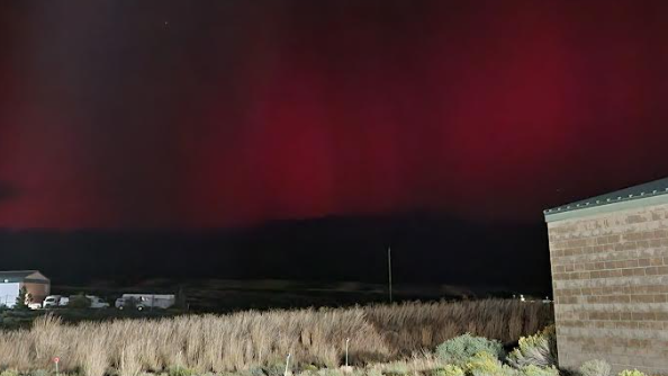Northern Lights possible again Friday as strong geomagnetic storm underway
NOAA’s Space Weather Prediction Center said strong (level 3 out of 5) geomagnetic storm levels were measured on Thursday morning. Friday could bring another chance to see the Northern Lights with a moderate geomagnetic storm forecast.
Northern lights dance above Glasgow, Montana
FILE VIDEO: This National Weather Service video from the Glasgow, Montana office shows the Northern lights on Sunday, Aug. 11, 2024 during a geomagnetic storm.
Charged particles crashing into Earth created strong solar storm conditions on Thursday, and a Geomagnetic Storm Watch continues through at least Friday with additional sightings of the Northern Lights possible.
NOAA’s Space Weather Prediction Center in Boulder, Colorado, said strong (G3) geomagnetic storm levels were measured on Thursday morning as effects from a coronal mass ejection arrived from the Sun. NOAA rates solar storms on a five-level scale, with five being the most extreme and rarest space weather conditions.
A geomagnetic storm happens when a barrage of electrons smashes into Earth following a solar event like a coronal mass ejection. These interactions can cause problems with the power grid and satellites, but the public does not need to worry. A positive consequence of a solar storm is that these electrons interact with particles in Earth’s magnetic field, creating vivid displays known as the Aurora Borealis, also known as the Northern Lights.
Strong geomagnetic storms are less common. However, Earth experienced near global auroras in May, even as far south as Florida, when an extreme geomagnetic storm occurred because of two groups of extremely active sunspots.
7 FACTS ABOUT THE NORTHERN LIGHTS
Northern lights seen as far south as Las Vegas Thursday
Those up early on Thursday at the beginning of the strong geomagnetic storm were likely surprised to see Northern Lights in parts of the Northwest and across the Northern U.S.
The National Weather Service in Marquette, Michigan, shared this dazzling display of lights taken around 4:30 a.m.
Northern Lights were seen in California and southern Nevada, including on the Bureau of Land Management cameras near Angel Peak.
Despite the wildfire smoke in the region, the National Weather Service in Elko, Nevada, had a good view of the Northern lights on Thursday.

Aurora lights seen over Elko, Nevada on Sept. 12, 2024.
Unfortunately, the strongest effects of the geomagnetic storm will occur during the day on Thursday in the U.S., with Kp index levels hitting 7 out of 9.
There is still a chance to see more dancing lights in the early hours of Friday when space weather forecasters predict moderate geomagnetic storm levels and the opportunity for aurora from New York to Idaho.
